
When it comes to subwoofer performance, the design of the enclosure is just as important as the quality of the subwoofer itself. Subwoofer enclosures are responsible for optimizing the sound quality and clarity of the bass, making it a crucial component of any audio system. In this article, we will explore the different types of subwoofer enclosures available, and showcase 2 15-inch subwoofer box designs that can help you achieve maximum sound quality.
The first type of subwoofer enclosure is the sealed box. Sealed boxes provide a tight, accurate bass response and are ideal for music genres that require precision, such as jazz, classical, and acoustic. The design of a sealed box is relatively simple, and it involves creating a chamber that is completely sealed to prevent any air from escaping. This design reduces distortion and ensures a more accurate sound, but it may lack the volume and power of other subwoofer enclosures.
Our first 15-inch subwoofer box design uses a sealed box. The dimensions of the box are 24 inches wide, 16 inches tall, and 18 inches deep, with a volume of approximately 3.5 cubic feet. This design is perfect for those who prioritize accuracy and clarity, as it provides a tight, punchy bass response without sacrificing sound quality.
Another popular subwoofer enclosure type is the ported box. Ported boxes utilize a vent or port to allow air to escape from the enclosure, which increases efficiency and volume. Ported boxes are ideal for music genres that require a powerful, deep bass response, such as hip-hop, rock, and EDM. The design of a ported box involves creating a chamber that is vented to the outside, allowing air to escape and creating a more powerful bass response.
Our second 15-inch subwoofer box design uses a ported box. The dimensions of the box are 32 inches wide, 18 inches tall, and 24 inches deep, with a volume of approximately 8 cubic feet. The port is 4 inches in diameter and 20 inches long, and the box is tuned to a frequency of 32 Hz. This design provides a deep, powerful bass response that is ideal for music genres that require a strong bass presence.
In addition to sealed and ported boxes, there are also hybrid designs that combine the best of both worlds. Hybrid boxes utilize both sealed and ported elements to create a more balanced and nuanced sound, with the accuracy of a sealed box and the volume of a ported box. These designs require a bit more work to create, but they are well worth it for those who prioritize both sound quality and volume.
When designing a subwoofer box, there are a few key considerations to keep in mind. First and foremost, the size and shape of the enclosure should be carefully considered to match the subwoofer driver. Secondly, the type of music you will be listening to should be taken into account to determine which type of subwoofer enclosure will provide the best sound quality. Finally, the placement of the subwoofer box within your audio system is also critical, as the box should be positioned to maximize sound quality while minimizing distortion.
Subwoofer enclosure design is a crucial component of any audio system, and it can make all the difference in the quality of your listening experience. Sealed, ported, and hybrid boxes are all viable options depending on your musical preferences and desired sound quality. By taking the time to understand the principles of subwoofer enclosure design and experimenting with different designs, you can create a customized audio system that delivers the best possible sound quality.

